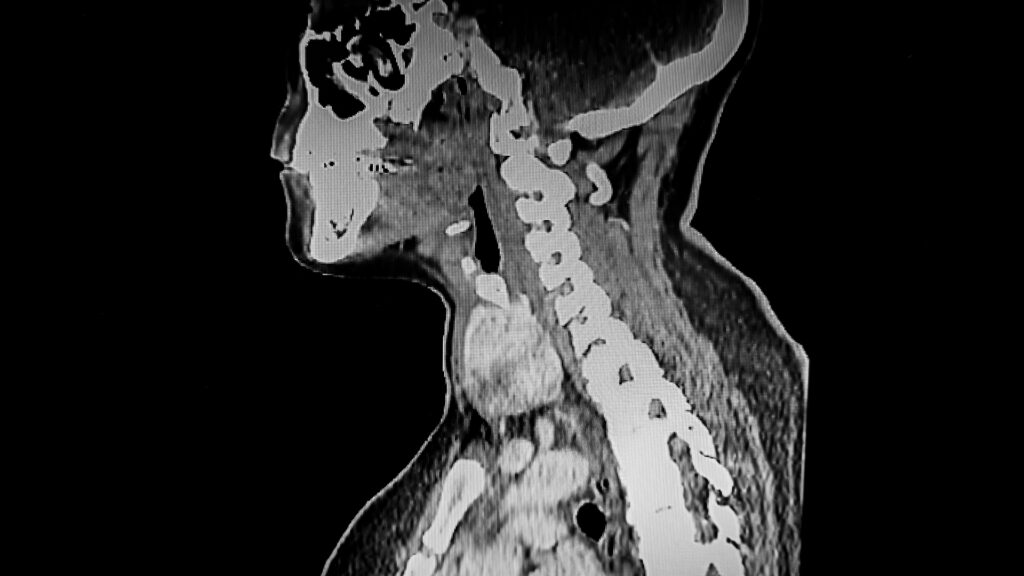
While thyroid cancer is somewhat less common than many other cancer types, it still greatly affects many patients. The American Cancer Society estimates 44,020 new thyroid cancer diagnoses with a 5-year survival rate of 98.4%. Fortunately, the death rate is relatively low, and improvements in both detection and treatment methods offer hope for reducing it even further.
This article provides a brief overview of thyroid cancer and how it is detected, with a focus on current treatment options and management methods.
The thyroid is a butterfly-shaped gland located at the base of the throat, wrapping around the trachea. It produces thyroid hormones involved in metabolism, growth during puberty, body temperature regulation, as well as bone and nervous system functions. Thyroid cancer develops when cells within the thyroid grow and spread out of control, often forming a nodule or tumor. In more advanced cases, they may spread to nearby lymph nodes or other parts of the body, such as organs and bones.
There are several types of thyroid cancer, including:

CT scan of a 4 cm thyroid nodule occupying the left lobe.
There are a variety of imaging techniques and tests used to diagnose thyroid cancer, many of which are used in combination. Common methods include:
The thyroid cancer staging system is used to determine whether cancer cells have spread to other parts of the body, which can make the disease harder to treat. Physicians may select treatment strategies differently, depending on the staging results.
Staging is based on several factors, including tumor size, patient age and whether lymph nodes or other organs are affected. Thyroid cancer staging can be somewhat complex and can vary depending on the exact type of thyroid cancer.
While anaplastic and medullary thyroid cancers have unique staging factors, here is a simplified overview of papillary thyroid cancer staging, as it is by far the most common type. Note, because of the good prognosis for younger patients with differentiated thyroid cancers, such as papillary thyroid cancer, they only have two unique categorized stages. Patients over 55 have additional stages:
For patients under 55:
For patients over 55:
There are various thyroid cancer treatment methods, many of which are used in combination. Here is a brief overview of current treatment options.
Surgery is one of the most common methods used to treat thyroid cancer. The most frequently performed procedure is a thyroidectomy, where the entire thyroid gland is taken out. If tumors are smaller, however, only the part of the thyroid containing the tumor may be surgically removed, a procedure called a lobectomy.
If nearby lymph nodes appear to be affected, they can also be surgically extracted. In fact, some physicians recommend this regardless, as it can help reduce the chance of thyroid cancer recurrence. Surgical recommendations are usually based on factors such as the stage of the disease, the patient’s age and their overall health.
Radioactive iodine therapy (RAI) is a common treatment for thyroid cancer, though not all types respond to this method. Radioactive iodine is usually given orally, where it collects within thyroid tissue. Both normal thyroid tissue and thyroid cancer cells absorb the iodine, while most other cells in the body remain unaffected. This makes RAI an effective way to kill cancer cells, especially when combined with surgery.
Anaplastic and medullary thyroid cancers do not respond to RAI because their cancer cells do not absorb iodine. In these cases, a different form of treatment would be suggested instead.
External beam radiation therapy is another common treatment for thyroid cancers, especially anaplastic and medullary types. This technique uses high-energy rays, such as X-rays, to target and destroy cancer cells. It is often used for patients whose cancer has spread beyond the thyroid, since it can also treat other affected areas. Treatment sessions are generally quick and painless, though the technician will likely spend some time calibrating and aiming the equipment correctly. Possible side effects of radiation therapy include:
Chemotherapy uses specialized drugs to kill cancer cells and prevent them from spreading. Unlike many other types of cancer, chemotherapy is not commonly used to treat thyroid cancer. However, it may be suitable for patients with anaplastic thyroid cancer, especially when combined with external beam radiation therapy.
Cancer cells often have unique features that make them behave differently from normal cells. Some rely on specific proteins to fuel their growth, while others carry mutated genes that alter how proteins function in support of cancer progression.
Targeted therapy uses drugs that act on these specific factors to deprive the cancer of fuel and help slow or shrink the tumor. In thyroid cancer, targeted therapy commonly involves kinase inhibitors. Kinases are proteins that normally relay signals to cells, such as directing them to grow. Various targeted therapy drugs block these types of proteins. The specific drugs used will depend on the type of thyroid cancer and other individual characteristics.
For patients who have had their thyroid removed, hormone therapy may be used to replace the hormones no longer produced by the absent thyroid. This not only supports the body’s metabolic function and other thyroid-related processes, but it can also help reduce the risk of thyroid cancer recurrence. Thyroid-stimulating hormone (TSH), produced by the pituitary gland, prompts the thyroid to produce hormones. TSH can also stimulate the growth of thyroid tissue and, potentially, thyroid cancer cells.
Because of this connection, patients may receive higher doses of thyroid hormone to suppress TSH levels. By preventing elevated TSH from stimulating cancer cell growth, this approach can reduce the risk of recurrence and slow the progression of any remaining cancer.
Your thyroid imaging results are interpreted by a radiologist—an expert in medical imaging—who carefully reviews your scans and provides a detailed report of any findings. This report is then sent to your referring physician, who, with a deeper understanding of your medical history and past exams, can offer further insights and recommendations on next steps in a follow-up appointment.
Turnaround times for imaging results can vary widely depending on the facility and your doctor’s availability. Often, patients wait a week or more and receive their results during a follow-up appointment. With PocketHealth, your imaging results are securely accessible as soon as they’re approved for release by the hospital or imaging clinic. This allows you the opportunity to review your results and prepare questions ahead of your follow-up visit.
To help you understand your thyroid imaging results, PocketHealth provides clear definitions and illustrations for complex medical terms—plus an in-depth explanation of your full imaging report. This is paired with highlights of key anatomy in your imaging to help you better comprehend what you’re looking at.
Here are some frequently asked questions regarding thyroid cancer.
The most common initial treatment for thyroid cancer is surgery, which may involve partial or total removal of the thyroid gland, depending on the stage of the disease. Additional treatments, such as radioactive iodine therapy, may be recommended based on the type and stage of the cancer.
Some patients may be given the option to postpone or avoid surgery if their thyroid cancer meets specific criteria, such as being categorized as a subtype of small papillary thyroid cancer. In these cases, the tumor is typically 1.5 cm or smaller, which means it is generally slow-growing and less aggressive.
Because of the high survival rate in such cases, some patients may choose to undergo “active surveillance,” which involves regular medical evaluations to monitor whether the cancer begins to spread or remains stable. This “watchful waiting” approach allows patients to delay surgery and its potential side effects until it becomes medically necessary or personally desired.
Active surveillance should be discussed thoroughly with medical providers, as not every cancer case is suitable for this approach. Recommendations are typically made on a case-by-case basis, so if you have questions, you should consult your doctor. It’s also important to note that patients usually have the option to change their minds during the course of active surveillance and may request to move forward with surgery at any time.
Specific recommendations on what to avoid with thyroid cancer may vary depending on the patient’s underlying health, the type of thyroid cancer and their doctor’s guidance. Differentiated thyroid cancers are commonly treated with radioactive iodine therapy, which may require avoiding iodine-rich foods for a period before treatment. In these cases, physicians will provide specific instructions tailored to the patient’s needs.
Besides iodine-rich foods, there may be other substances or activities that should be avoided, such as certain supplements that could interfere with treatments or medications. Physicians should provide guidance on these factors, though it can be helpful to ask for detailed recommendations.
Immediate side effects of a thyroidectomy may include a hoarse voice (usually temporary) and low calcium levels if the parathyroid glands (located behind the thyroid) are affected during surgery. Seromas (fluid buildup at the incision site) may also occur, though they often resolve on their own or can be drained by a physician if needed. In terms of long-term effects, patients will need to take thyroid hormone replacement for the rest of their lives. However, studies show that thyroidectomies are generally low risk and rarely lead to long-term complications.
While certain factors may increase your risk of developing thyroid cancer, this does not mean you will get the disease. In fact, most people with risk factors do not develop thyroid cancer. However, knowing if you are at higher risk can be helpful, as it may be worth discussing with your physician. They may recommend precautionary screenings, such as a physical exam to check for nodules. The American Cancer Society currently lists the following risk factors:
A goiter is an enlarged thyroid gland, often appearing as a lump or swelling in the neck. While goiters can sometimes be associated with thyroid cancer, they are most often caused by benign conditions, including:
Getting a thyroid cancer diagnosis can feel overwhelming, but it’s important to remember you’re not alone. Your doctor will likely have access to local support and resources you can use. In addition, here are some online resources that may be helpful for educational, financial and emotional support:
PocketHealth makes it simple to keep track of your medical imaging results. All of your images and reports are permanently available in one secure location and can be accessed online—anytime, anywhere. Reports can also be easily shared with other members of your care team, if needed. When used in conjunction with your medical provider’s professional advice, it is a powerful tool to better understand your imaging results.
PocketHealth also provides personalized health insights based on the findings in your report to help you stay on top of any next steps. This includes clearly surfacing any follow-up actions found in your report and generating customized questions to ask your doctor so you can make the most of your follow-up appointment.
While a thyroid cancer diagnosis is scary and overwhelming, better understanding your results and working closely with your healthcare team can give you the best chance of managing your condition and protecting your health.
Published: August 21, 2025
Trusted by more than 800+ hospitals and clinics.











